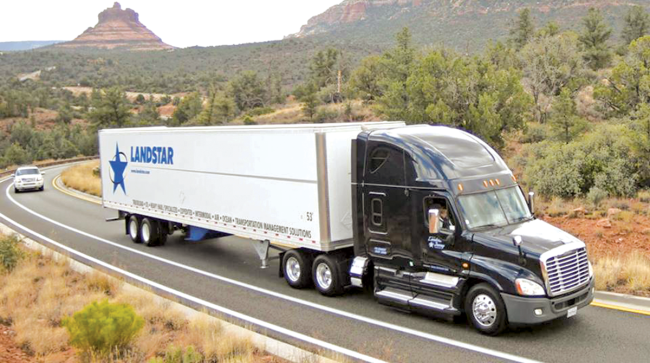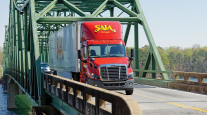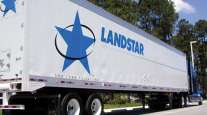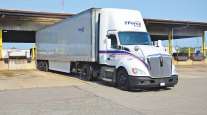Staff Reporter
Landstar Reports 28% Revenue Decline for Q4

[Stay on top of transportation news: Get TTNews in your inbox.]
Landstar System Inc. posted declines in net income and revenue during the fourth quarter of 2023, the company reported Jan. 31.
The Jacksonville, Fla.-based motor carrier said Q4 revenue decreased 28.1% to $1.2 billion compared with $1.68 billion for the three months ending Dec. 31. Landstar’s net income slid to $58 million, or $1.62 a diluted share, compared with $93.3 million, or $2.60, the previous year.
“We entered 2023 with a challenging freight environment and very difficult year-over-year comparisons coming off a record 2022,” CEO Jim Gattoni said during a Feb. 1 conference call with investors and analysts. “Landstar’s revenue performance through the freight cycles that occurred over the past four years ultimately set the stage for where we are today.”
Gattoni noted that sequential quarter-to-quarter revenue trends were above seasonal norms from the start of the pandemic to when the company achieved record revenue in the second quarter of 2022, a revenue up cycle that lasted seven quarters. Since then, he said, quarter-to-quarter revenue has decreased below historical seasonal trends for six consecutive quarters.
“Generally, in the ordinary course of our business, we experience down cycles that drive revenue from peak-to-trough, as well as up cycles that drive revenue from trough-to-peak, with each peak-and-trough being higher than the last,” Gattoni said. “In the case of either down cycles or up cycles, freight cycles tend to move from peak-to-trough or trough-to-peak over six to eight quarters.”
Gattoni added that these cycles are typically driven by three main factors: the level of industry demand for freight services; the level of available truck capacity; and the differential between industrywide contract and spot pricing at any given point. He is expecting above-normal seasonal revenue growth around midyear since the current down cycle has lasted six straight quarters.
“We expect first-quarter 2024 revenue per truckload and number of loads hauled via truck to track in line with seasonal norms following the 2023 fourth quarter,” Gattoni said. “This expectation is driven by the trends in revenue per truckload and truckload volume in the first several weeks of January and the weaker than normal peak season in the 2023 fourth quarter.”
Gattoni noted the expectation of a cycle upturn midyear also suggests increasing demand, a shift in mix toward truck brokerage and a somewhat tighter truck capacity market throughout the year. He expects revenue in the first quarter to range between $1.1 billion and $1.15 billion.
Landstar’s Q4 results were slightly below expectations from Wall Street analysts, who were expecting EPS of $1.63 per share and quarterly revenue of $1.25 billion, according to Zacks Consensus Estimate.
How does hydrogen fuel cell technology fit into freight transportation? Find out with Parker Meeks, the CEO of Hyzon, a company that designs and manufactures fuel cell technology for heavy-duty transport applications. Tune in above or by going to RoadSigns.ttnews.com.
Landstar noted that the number of loads hauled via trucks during the quarter declined 22% year-over-year and that truck revenue per load declined 10% over that same time. Both metrics were near the low end of the company’s previously issued guidance.
For the quarter, the company said truck transportation revenue hauled by independent business capacity owners and truck brokerage carriers decreased 29.2% to $1.09 billion from $1.53 billion the previous year. These operations represent 90% of revenue and include truckload operations such as van equipment as well as unsided/platform equipment. It also includes less-than-truckload and other truck transportation operations.
More specifically, during the quarter:
- Truckload transportation revenue hauled via van equipment decreased 28.9% to $618.6 million from $869.8 million in the prior-year quarter.
- Truckload transportation revenue hauled via unsided/platform equipment decreased 19.7% to $339.9 million from $423.4 million.
- LTL revenue decreased 26.2% to $26.9 million from $36.4 million.
Landstar also noted in the report that revenue hauled by rail, air and ocean cargo carriers collectively decreased by 23% in Q4 to $88.6 million from $115.1 million during the same time the previous year.
For the full year, Landstar saw net income fall to $264.4 million, or $7.36 a share, compared with $430.9 million, or $11.76, in 2022. Full-year revenue fell to $5.3 billion compared with $7.44 billion in 2022.
Landstar ranks No. 6 on the Transport Topics Top 100 list of the largest for-hire carriers in North America and No. 19 on the TT Top 100 logistics companies list.
Want more news? Listen to today's daily briefing below or go here for more info:





